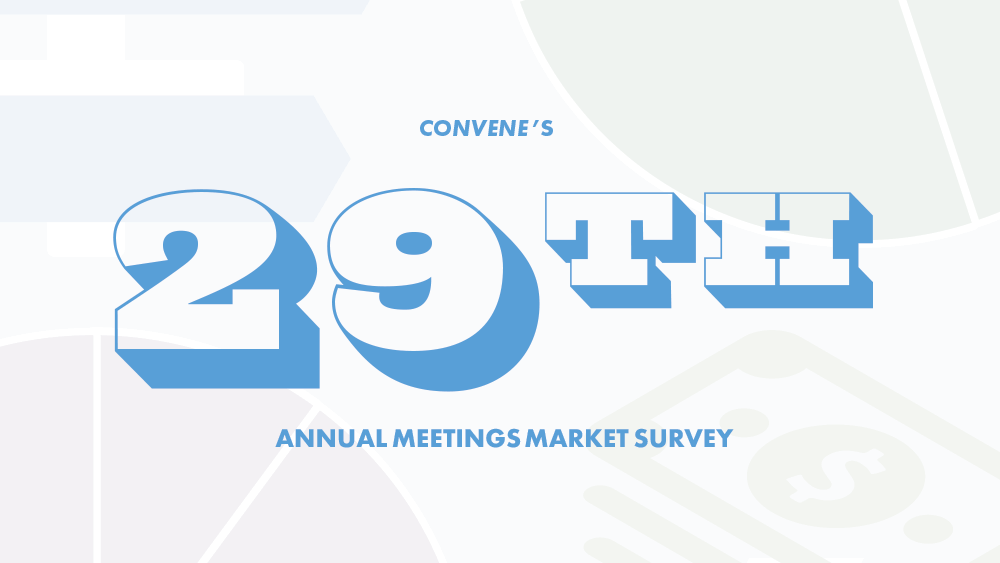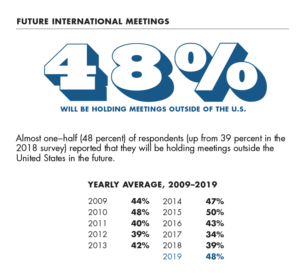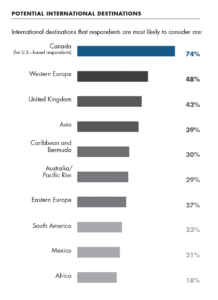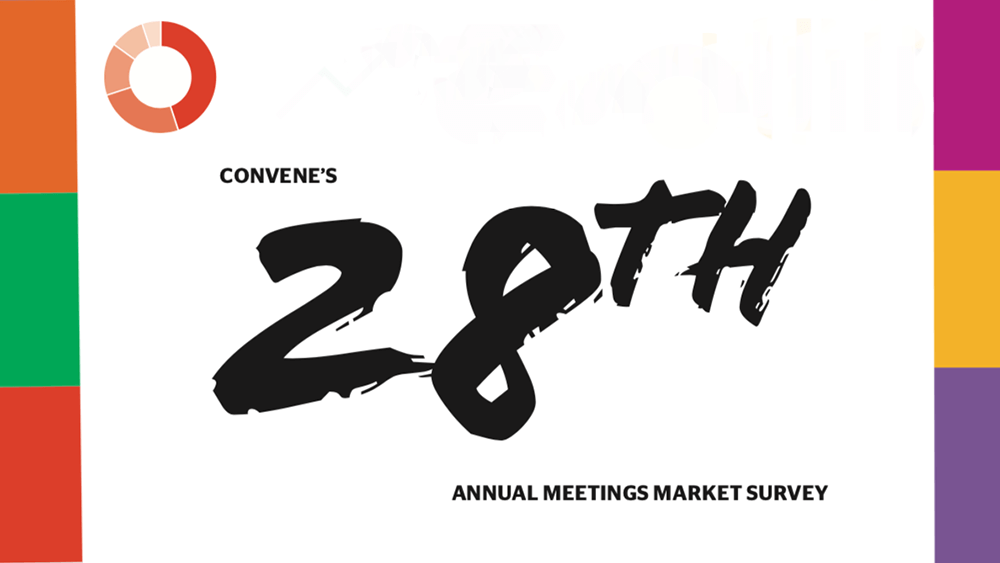
The business events industry is on solid footing — for now — according to responses to Convene’s 29th annual meetings market survey.
What’s the No. 1 challenge facing the business events industry? When we posed this question in November 2019 to more than 800 industry professional respondents, only a handful talked about dealing with the unknown. But one respondent stood out as being prescient, writing: “I believe the risk management piece is the No. 1 challenge at this point, from small risks like flight cancellations to major — epidemic outbreak and natural disasters.”
That was, of course, several months before news of the spread of the COVID-19 coronavirus, which at the time of this writing, was still an evolving crisis and will look different once this issue is published. But at this particular point in time, using SARS — which sickened 8,098 and killed 774 before it was contained after four months in 2003 — as a measuring stick of the negative impact of an epidemic, COVID-19 has the potential to do more economic damage.

Participants responded to the survey well before the COVID-19 outbreak, which may well have changed their answers to the survey questions above and below about international meetings.
That’s not only because the virus has already sickened and killed far more people, but because economies are now much more interconnected than they were 17 years ago. And yet, at the same time, CNN Business reports, “rising nationalism may make it harder to coordinate a worldwide response, if that’s required.”
So events — barring the obvious negative impact in terms of revenue and knowledge exchange for those that are scheduled in the first half of the year in Asia and/or which depend on a sizable Chinese contingency of participants — will feel the ripple effect of an economic downturn. “The outbreak has the potential to cause severe economic and market  dislocation,” Neil Shearing, group chief economist at Capital Economics told CNN Business. “But the scale of the impact will ultimately be determined by how the virus spreads and evolves, which is almost impossible to predict, as well as how governments respond.”
dislocation,” Neil Shearing, group chief economist at Capital Economics told CNN Business. “But the scale of the impact will ultimately be determined by how the virus spreads and evolves, which is almost impossible to predict, as well as how governments respond.”
In terms of the effect on travel, Gloria Guevara, president and CEO of the World Travel and Tourism Council (WTTC), said that she fears that airport closures, flight cancellations, and shuttered borders will have a greater economic impact than the outbreak itself. And as far as tourism is concerned, according to an article in The Conversation, “The pain [caused by the coronavirus] “will be felt in every industry as tourism’s supply chain involves everything from agriculture and fishing to banking and insurance. The hardest hit will be its core industries of accommodation, food and beverage services, recreation and entertainment, transportation, and travel services.”
To say nothing of the global $1.2 trillion MICE industry.
Fourteen percent of respondents to this year’s survey said that more than a quarter of attendees at their largest 2019 event were international, and 19 percent expected the number of international attendees to increase at their 2020 event. How these events and others will be impacted this year remains to be seen, and depends on participants’ country of origin, their host destinations, and when scheduled. And while nearly nine out of 10 respondents reported that it was more difficult for potential registrants to obtain visas in 2019 than 2018, that might not be the greatest of their challenges when it comes to international attendance in 2020.
In the meantime, here is a look back to what event professionals said late last year was their experience in 2019 and what they expected in the year ahead.
- Size of 2019 convention/meeting budget vs. 2018 convention/meeting budget — +1.6 percent compared to +2 percent in the 2018 survey
- 2019 attendance vs. 2018 attendance — +4 percent compared to +5 percent in the 2018 survey
- 2020 attendance vs. 2019 attendance (projected) — +4.5 percent compared to +4.4 percent in the 2019 survey
- Number of 2019 exhibitors vs. 2018 exhibitors — +2.6 percent, the same as in the 2018 survey
- Number of 2020 exhibitors vs. 2019 exhibitors (projected) — +2.2 percent compared to +1.9 percent in the 2018 survey
- Number of meetings planned — 40 percent expect to plan more meetings in 2020; only 6 percent expect to plan fewer meetings.
- Economizing — Most event organizers are still being asked to reduce meeting expenses, and the majority (63 percent) has been asked to focus on cutting back on F&B expenses, followed by AV costs (43 percent).
- Larger footprint — Total exhibition space for this year’s group of respondents was greater than that of respondents to last year’s survey. On average, the largest exposition among this year’s respondents was approximately 114,100 net square feet vs. 100,700 net square feet in the 2018 survey.
- No more or less — The average booking window for large meetings is 2.2 years; for small meetings, it’s 10 months — around the same for both as in the 2018 survey.
- Outside help — Respondents to this year’s survey were most likely to outsource event-supply rentals (65 percent), followed by app development and deployment (56 percent), and registration (48 percent).
When respondents were asked to write in their No. 1 on-the-job challenge, what came up most frequently could be lumped in one category: budget crunches/rising costs/and insufficient resources. The next most-often voiced issue was work/life balance and a lack of time to get the job done. That was followed by internal frustrations — difficulty in conveying the value of their work to others, most often their superiors. A number of respondents mentioned issues working with vendors, as well as dealing with technology.
RELATED: Who Responded to the Meetings Market Survey
One technology that respondents seemed to embrace more last year was featuring a virtual/hybrid element at their largest event — 31 percent compared to 20 percent in last year’s survey, and 23 percent of respondents reported they included more virtual/ hybrid elements in their events than the year before. Of those that had a virtual/hybrid component, 62 percent introduced an interactive element for their online audience, such as chat, polling, and Q&A. It will be interesting to see if this will be a breakout year for virtual/ hybrid events as they may be used to engage attendees who are unable to travel due to COVID-19.
Only one-quarter said that they introduced new technology at their events in 2019, and only 28 percent said that their organization has changed how it collects and uses participant data. Data collection, however, seems to be a growing responsibility among planners: Sixty-two percent said they have a hands-on role in its collection and analysis.
Among the social-media tools respondents use for marketing to and engaging with their event audiences, Facebook and Twitter are tied, followed by LinkedIn and Instagram.
Most respondents said they favor an experiential approach to site selection: Site visits top the list (48 percent said it’s their first preference). Online searches (23 percent) and one-on-one sales interactions (21 percent) follow as primary methods planners use to evaluate meeting sites.
RELATED: Data Tells the Story
This is the second year that we asked whether respondents include a community-service project in their events: A little more than half (51 percent) said no. Of those that do, only 4 percent include a CSR activity at every event; 13 percent only at their largest event; and 32 percent said that they feature one occasionally. These results are similar to last year’s survey.
As for how much of a priority event organizers place on environmental sustainability at their events, only 14 percent said that they make this top of mind and include environmental elements in their RFPs, only a few points more than last year. However, 61 percent said it’s somewhat important to them, compared to 53 percent in last year’s survey, and only 25 percent said sustainability is not part of their planning efforts at this time, compared to 36 percent in last year’s survey.
The sharing economy continues to make only a small dent in room-block management. Only 28 percent (compared to 22 percent in last year’s survey) said that they expect that a percentage — 11 percent on average, more than double than the 5-percent average reported in 2018 — of their registrants will use Airbnb (or another shared-housing platform) rather than their headquarters hotels or hotels in their room block.
Stats and percentages are telling, but there’s nothing like mining through respondents’ open-ended comments to get a sense of what’s on their minds. Here’s a sampling.
What’s the No. 1 Challenge Facing the Meetings Industry?
“As climate emergency gets worse, I worry that people will see meetings as frivolous.”
“Relevance: How do we convince people to leave their homes and come here. How do we also get people off their phones, to put their computers away, and to really be present in the experience?”
“The events industry presents a great way to be creative if only we are brave enough to embrace disruptive thinking.”
What’s Your No. 1 On-The-Job Challenge?
“Attendees. It’s very hard to please them as consumers in the age of social media. It’s also hard to have a pulse on what is new and different, figuring out what will be important at showtime, rather than what is happen- ing now. Will people care about certain issues or top- ics that we’re making a big deal about right now or are we wasting time putting it in the largest spaces? And staying relevant in the market — we’re the only event that focuses on our audience, but what about the splinter groups that are offering only online options or more aggressive approaches?”
“I belong here — this is my community. My greatest challenge is part event strategy, part neuropsychology, part marketing, part sponsorship and part magic! Belonging. Community. Loyalty. These create a direct hotline to potential attendees and sponsors. If we get this right, we secure sponsors and attendees’ commitment and active engagement. Creating this feeling is a daily challenge for me and event professionals worldwide. Doing this successfully is key to achieving sponsorship and registration targets. With global economic conditions being what they are, there is less money for supporting meeting attendance and less money for meeting sponsorship. Couple that with an ever-increasing number of competing events, and it is becoming crucial to find a way to connect with potential attendees and sponsors.”
“Introducing high-quality content in an engaging, experiential manner.”
“Negotiating costs, especially with one major brand driving the bus.”
“Keeping up with expensive technological advances.”
“Justification for meeting in person, given the environmental impact. As a charity, we are taking a hard look at the need to hold all of our meetings in person — with our global stakeholders, our environmental impact is huge and the costs are getting way too high to justify.”
More Results of the 29th Annual Meetings Market Survey
Scroll through the pages below to see additional results. For a larger version, click the pop-out square in the upper right-hand corner of the window.
Michelle Russell is Convene’s editor in chief.
Convene’s Meetings Market Survey was prepared for PCMA by Lewis Copulsky, principal, Lewis & Clark. All material © 2020 by PCMA. Survey analysis by Convene Editor in Chief Michelle Russell.
2019 Meetings Market Survey Results
Planners Optimistic About Growth Ahead
Respondents to the 2019 survey anticipate that they will have more attendees and exhibitors at their events in 2019 vs. in 2018. It remains to be seen whether market forces will temper expectations.

